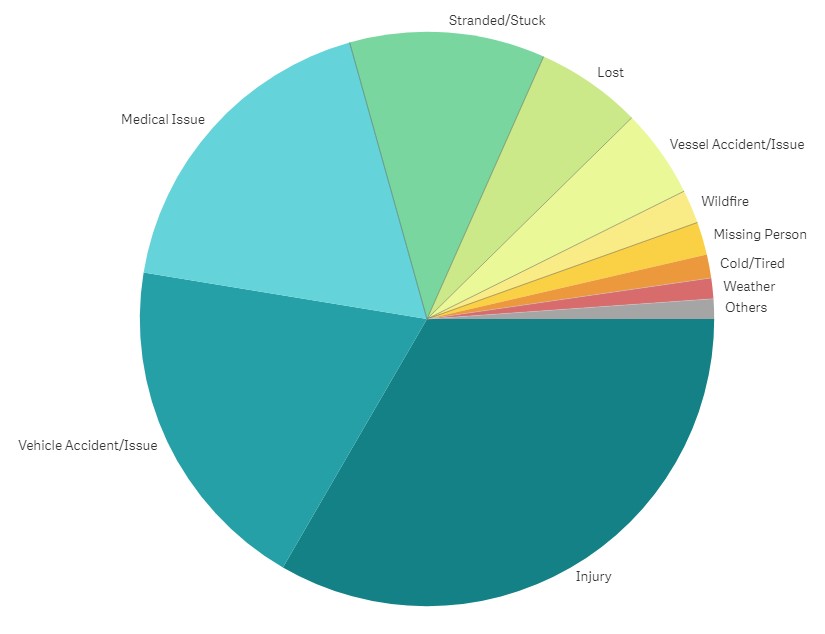Garmin SOS report details all the times its InReach satellites saved people's lives last year
Garmin reports that its InReach SOS program is used almost as often for auto and motorcycle accidents as for hiking emergencies.

What you need to know
- Garmin released its 2023 InReach SOS Report on Thursday, detailing the circumstances in which Garmin users needed emergency assistance.
- Users were most commonly hiking, driving, motorcycling, boating, mountaineering, or camping when requiring SOS assistance.
- Garmin uses Iridium satellites and a 24/7 Garmin Response emergency service center available in over 200 countries and 210 languages.
- Garmin has responded to over 10,000 SOS requests as of 2022.
Garmin has published a report on when, where, and in what context Garmin InReach users sent out an SOS warning throughout 2023. According to Garmin, its emergency response team answered requests across 100 countries and three oceans.
The 2023 SOS Year in Review report explains that their responses covered "plane crashes, grizzly bear encounters, sinking sailboats, skiers in avalanches, stranded divers, injured climbers," and other incidents across six continents. The Garmin Response service coordinates with local EMS teams in over 200 countries.
The charts below show some interesting insights for the context of when Garmin users needed saving. For instance, while perhaps 1/3 of incidents took place while hiking or backpacking, nearly just as many incidents were reported while driving, motorcycling, or boating. For people living in poor cellular coverage, Garmin InReach also came in handy for non-fitness or camping situations.

"Injury" or "medical issue" were two of the three most common reasons for an SOS, unsurprisingly, with car accidents taking the second-highest spot. Other calls for help came when users were lost, stranded, in sight of a wildfire, or trying to find another missing person.

To that last point, Garmin also explained that less than half of reports were for the InReach user calling solely for themselves. Just as many were for traveling companions or other groups that the users spotted in danger.

Rounding out the data report, Garmin helped facilitate helicopters, ambulances, search and rescue, police response, vehicle towing, and fire response, though the report also explained that it helped users "self-rescue" 10% of the time, avoiding the expense of search and rescue. At present, Garmin charges $39 per year for SAR insurance, on top of InReach costs.

Although Garmin declined to publicly share the specific number of times an SOS was triggered, it did report in 2022 that it had responded to 10,000 SOS incidents after 11 years, with the number per year likely increasing over time.
Be an expert in 5 minutes
Get the latest news from Android Central, your trusted companion in the world of Android
SOS functionality and satellite connectivity for emergencies have become more popular features in the last couple of years, with brands like Apple boasting in ads about how many lives they've saved. But it's not always clear how necessary it is to everyday people. This Garmin SOS report provides data that could help you decide if you need InReach access or another satellite service.

In lieu of satellite data, Garmin watches often have fall detection, with the ability to send a message to emergency services or your emergency contacts through your connected smartphone. If you're out of cell range, however, you're out of luck.
What holds most people back from using InReach is the cost. We've tested devices like the InReach Messenger and GPSMAP 67i that are very useful in emergencies but cost quite a bit upfront and then require an activation fee and monthly fee. They also let you message people outside of emergencies or allow family members to track your location in real time in case you are hurt but fail to send an SOS yourself.
Still, looking at a report like this, it becomes clearer that you'd rather have the option available than not if you're planning on an outdoor excursion somewhere with unreliable cell service.

Michael is Android Central's resident expert on wearables and fitness. Before joining Android Central, he freelanced for years at Techradar, Wareable, Windows Central, and Digital Trends. Channeling his love of running, he established himself as an expert on fitness watches, testing and reviewing models from Garmin, Fitbit, Samsung, Apple, COROS, Polar, Amazfit, Suunto, and more.
You must confirm your public display name before commenting
Please logout and then login again, you will then be prompted to enter your display name.
